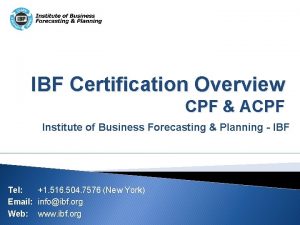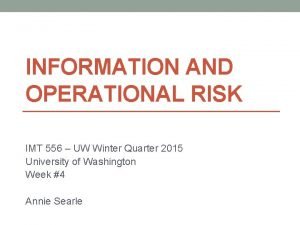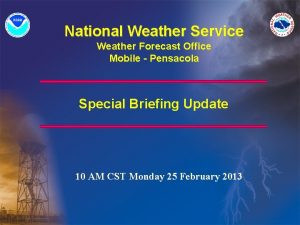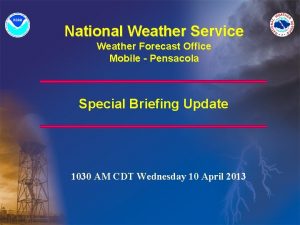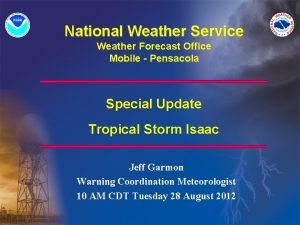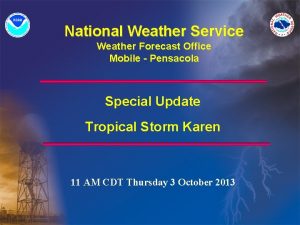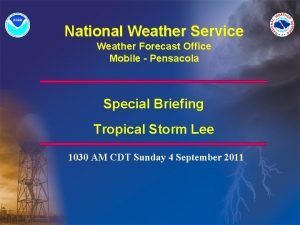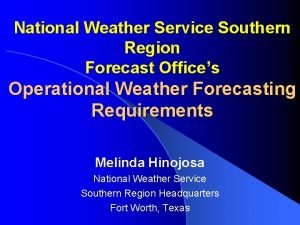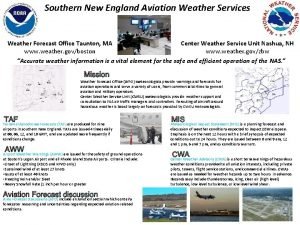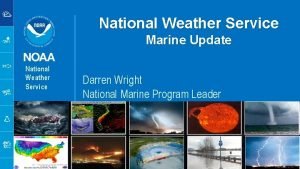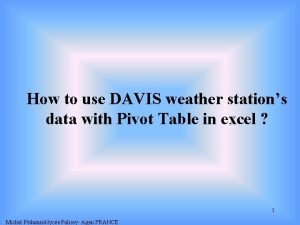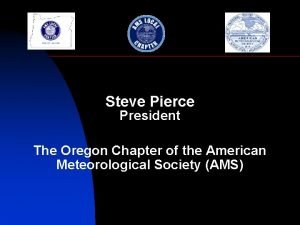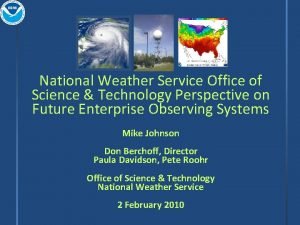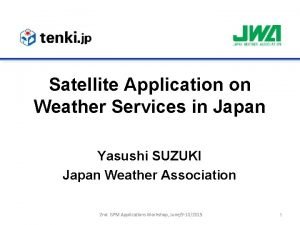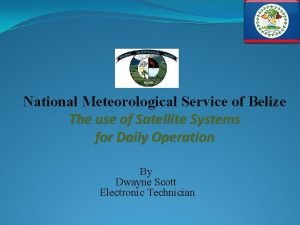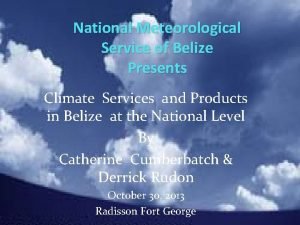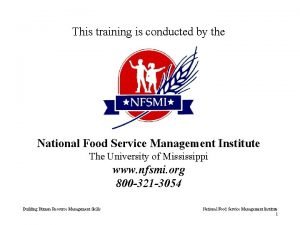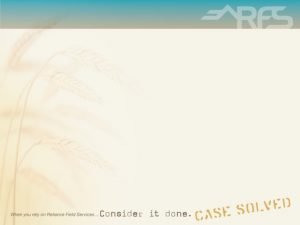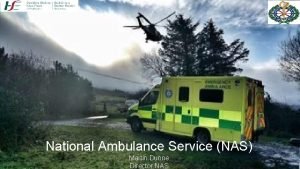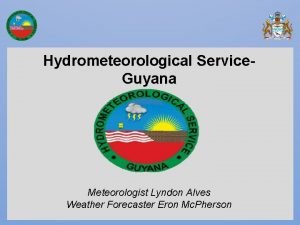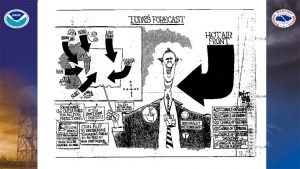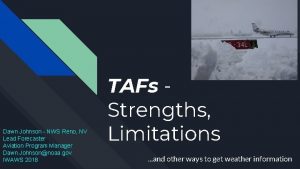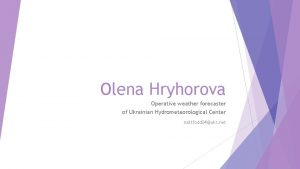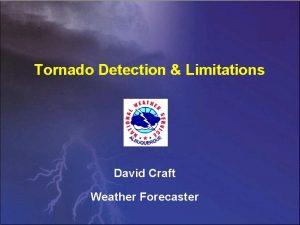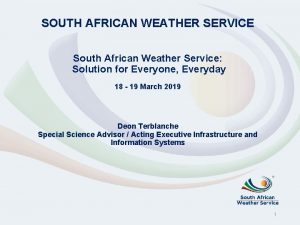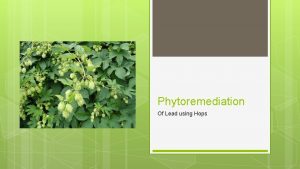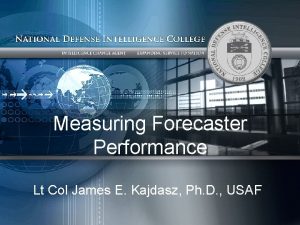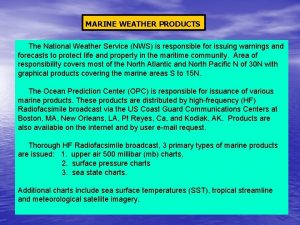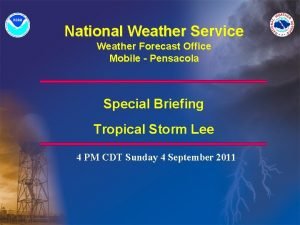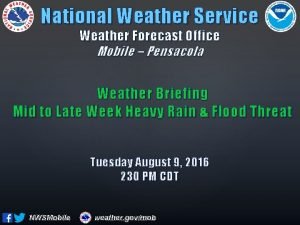National Weather Service Steve Davis Lead Forecaster With















































- Slides: 47

National Weather Service Steve Davis - Lead Forecaster With help from Paul Sirvatka Professor of Meteorology College of Du. Page Email : steve. c. davis@noaa. gov

Part I: Fundamentals - Radar Principles - Doppler Velocity Interpretation - SRV vs Base Velocity - Pre-storm Environment Analysis Outline Part II: Radar/Storm Interpretation - Thunderstorm Spectrum - Severe Storm Generalities - Les Lemon Criteria - Pulse Storms - Multicell Clusters/Lines - Supercells

Radar Basics

Beam Power Structure Side Lobe Energy ½ Power Point Max Power at center of beam ½ Power Point Side Lobes cause most of the clutter in close proximity to the radar The Radar Beam is defined by the half power points

Beam Power Structure • The side lobes can interfere with the signal and lead to ground clutter. • The beam width indicates why the beam must be elevated at least 1/2 degree so signal does not go straight down to the ground.

. 96 Degree Beam Resolution D = Beam Width Radar resolution with respect to beam width / range D If R = 60 NM 120 NM 180 NM 240 NM D= 1 NM 2 NM 3 NM 4 NM

Questions to Answer • What happens to resolution the further an object is from the radar? See page 6 of 7 from the Radar notes. • Which is better for resolution, a 2 degree beam width or a 1 degree beam width? (See page 4 of 7. ) Why? • How wide is the beam at 100 nautical miles from the radar?

Azimuth Resolution Considerations Rotational couplet identification can be affected by azimuth resolution. As the diagram shows, the closer a rotation is to the radar the more likely it will be identified correctly. If the rotation is smaller than the 10 beam width (possible at long ranges) then the rotation will be diluted or averaged by all the velocities in that sample volume. This may cause the couplet to go unidentified until it gets closer to the radar. Enlarged image along a radial. Individual “blocks” represent one sample volume. This graphically shows the radar resolution. Azimuth 3 Weak inbound, weak outbound Rotation too small to be resolved Strong inbound, strong outbound Azimuth 2 Azimuth 1 Stronger inbound than outbound

Pulse Repetition Frequency- PRF controls the Max Radar Range and Max Unambiguous Velocities PRF is the number of pulses per second transmitted by a radar Question to Answer: When an echo is range folded, how far in does it get folded in? (See page 3 of 7 in the radar notes. )

The Doppler Dilemma Rmax and Vmax depend on PRF Rmax = The range to which a transmitted pulse can travel and return to the radar before the next pulse is transmitted. Vmax = The maximum mean radial velocity that the radar can unambiguously measure (before dealiasing). * Rmax is inversely related to PRF * Vmax is directly related to PRF As PRF increases, Rmax decreases and Vmax Increases! The Doppler Dilemma: There is no single PRF that maximizes both Rmax and Vmax

Defeating the Doppler Dilemma The WSR-88 D employs a dual PRF scanning strategy to help defeat the “Doppler Dilemma” The 88 D performs redundant sampling on the lowest 2 elevation slices and interlaced sampling on the “middle” slices to maximize range/velocity data, and minimize ground clutter. CS = Contiguous Surveillance B = Batch CD = Contiguous Doppler CDX = Contiguous Doppler X In this example of Volume Coverage Pattern (VCP) 21, the lowest two elevation slices are sampled twice. Once using a low PRF (CS) to maximize range data and then again using a high PRF (CD) to maximize velocity data. The middle slices (blue) are sampled once but use an alternating, or interlaced, high and low PRF (B) on each radial. The upper elevation slices use only a high PRF (CDX) to maximize velocity data. Range issues are not a problem in the higher elevations, precluding the use of a low PRF.

Volume Coverage Patterns of the 88 -D Precipitation Mode: VCP 11 14 Slices*/5 minutes VCP 21 9 Slices*/6 minutes Clear Air Mode: VCP 31 5 Slices*/10 minutes (Long Pulse) VCP 32 5 Slices*/10 minutes (Short Pulse) * Add 2 more slices to every VCP because the bottom two slices are sampled twice. See previous slide.

Questions to Answer • Compare VCP’s from pages 6 and 7 of the radar notes. Which one would be best detecting very light precipitation? • Which one would be best for a strong storm that is about 40 nmi from the radar?

Atmospheric Refraction The radar assumes the beam is undergoing standard refraction. The beam height will be misrepresented under super/sub-refractive conditions. r Sub on cti a r f e tion ac r f e R d ndar Sta Superrefraction Note: Each beam starts at the same elevation angle and should be curved. Max cores may be displayed at wrong heights Superrefraction: The beam refracts more than standard. The beam height is lower than the radar indicates. Subrefraction: The beam refracts less than standard. The beam height is higher than the radar indicates. Beam can overshoot developing storms.

Super/Sub Refraction Super Refraction This occurs when the beam propagates through a layer where : - Temperature increases with height - Moisture decreases sharply with height * Radiation or subsidence inversion * Warm, dry air advecting over cooler water surface * Thunderstorm outflow ü Will likely produce ground clutter Sub Refraction This occurs when the beam propagates through a layer where : - Temperature lapse rate is ~ dry-adiabatic - Moisture content increases with height * Inverted V sounding (mid-afternoon, well mixed environment) ü Will help eliminate ground clutter

Beam Height vs. Range Standard Refraction Assumed 4. 30 Height AGL in Kft Range (nm)

Odd Phenomena Seen on Radar Ø Chaff - Look for it coming from the Military Operations Areas Ø Migrating birds rising from nesting areas around sunrise and sunset Ø Smoke from fires Ø Sunrise/Sunset spike Ø The unexplainable…

* * Doppler Velocity Interpretation * *

The Zero Isodop “Problem” When the radial is perpendicular to the wind, the radar displays zero velocity - This “zero zone” is called the “Zero Isodop”. What percentage of actual wind will the radar detect? When the wind velocity is parallel to the radial, the full component of the wind is measured 00 = 100% - Parallel 150 = 97% 300 = 87% 450 = 71% 600 = 50% 750 = 26% 900 = 0% - Perpendicular

Questions to Answer: • Go to http: //weather. ncbuy. com/glossary. html and define radial velocity. • If velocity is toward the radar directly, the velocity indicated is ____%. • If the velocity is perpendicular to the radar beam, the velocity indicated is ____%. • Study and take notes off the following page: http: //www. radar. mcgill. ca/science/exinstrument/ex-scanning-radar. html

Large Scale Winds Use the Zero Isodop to assess the vertical wind profile. The combination shape of the zero isodop indicates both veering and backing winds with height. Combination “S” Shape Backward “S” Shape “S” shape of the zero isodop indicates veering winds with height. Veering may imply warm air advection. Backward “S” shape of the zero isodop indicates backing winds with height. Backing may imply cold air advection.

Large Scale Winds Uniform Flow with Jet Core Straight Zero Isodop indicates uniform direction at all levels. The inbound/outbound max’s show a jetcore aloft with weaker winds above and below.

Example from KMKX 88 D Low level jet max January 5, 1994 Steady snowfall

The VAD Wind Profile (Velocity Azimuth Display) Plots out winds with respect to height as time increases from left to right

Small Scale Winds - Divergence/Convergence - In all of the following slides, note the position of the radar relative to the velocity signatures. This is critical for proper interpretation of the small scale velocity data. Divergent Signature Often seen at storm top level or near the ground at close range to a pulse type storm Convergence would show colors reversed

Small Scale Winds - Cyclonic Convergence/Divergence - Anticyclonic convergence/ divergence would show colors reversed in each panel. Cyclonic Convergence Cyclonic Divergence

Small Scale Winds - Pure Cyclonic Rotation - Anticyclonic rotation would show colors reversed Pure Cyclonic Rotation Example

Small Scale Velocity Example

Small Scale Velocity Example Rotation seen with the Big Flats Tornado. August 27, 1994 ~ 9 PM.

Storm Relative Velocity - SRV vs. Base Velocity In General: When diagnosing rotational characteristics, use SRV subtracts out the motion of a storm to display pure rotational characteristics of that storm. Often, the motion of the storm will mask or “dilute” the rotational information. This is especially true when rotations are subtle. When diagnosing Straight Line Winds (bow echo, derecho, microbursts), use Base Velocity The strength of an advancing line of storms producing straight line winds is a sum of the winds produced by the storms, plus the movement of the storms. Using SRV would take one component away. Examples

SRV vs. Base Velocity - Strong Rotation - Base Velocity Storm Relative Velocity Persistent rotation from Big Flats Storm

SRV vs Base Velocity - Subtle Rotation - Base Velocity Storm Relative Velocity Janesville F 2 tornado. June 25 th, 1998 ~ 700 PM Interesting note: These scans are at 3. 40 elevation. The 0. 50 elevation showed little rotational information.

SRV vs Base Velocity - Subtle Rotation - 3. 40 Base Velocity Little/no rotation seen at lowest elevation 0. 50 Storm Relative

SRV vs Base Velocity - Oakfield - Base Velocity Storm Relative Velocity Oakfield F 5 tornado. July 18, 1996. Although the rotation was intense, the low precip (LP) nature of the storm at this time, limited the amount of energy returned back to the 88 D by precipitation targets. In this case, though the rotation was strong, the SRV clearly was the better tool for diagnosing the strength of the rotation.

SRV vs Base Velocity - Straight Line Winds - Base velocity shows max inbound winds of 55 to 60 kts. SRV shows max inbound winds of 30 to 40 kts.

Something to Do: • Define the following and indicate what they would look like on a Doppler radar display: – – – Veering winds with height Backing winds with height Convergence Divergence Cyclonic rotation Anticyclonic rotation

Pre-Storm Environment The three main elements to assess are: Moisture, Stability and Lift Dewpoints/Precipitable Water LI’s CAPE Jet Position (coupling? ) Cap Strength/CIN Boundaries Wet Bulb Zero Helicity BRN Energy Helicity Index -EHI

LI’s and Moisture LI’s LI = -3 to -6 Moderately Unstable LI = -6 to -9 Very Unstable LI = < -9 Extremely Unstable* * LI’s even lower are increasingly likely to exist under a capped environment Best to use the most unstable parcel in a layer up to about 850 mb. A surfaced based LI may be unrepresentative if boundary layer is under a shallow inversion. Moisture Surface - 600 F dewpoint or higher 850 mb - 120 C dewpoint or higher 1000 -500 mb Precipitable water - 1. 5" or higher

CAPE CIN and Cap 700 mb +100 C used as edge of cap The edge of a cap is often a good place to watch for “Back-Building”, nearly stationary, flood producing storms. This is especially true if there is a focusing, trigger mechanism available.

Upper (low) Level Jet Influence

Shear and Thermal Instablility The most severe, organized storms occur in environments where the shear and thermal instability are both moderate or strong and well balanced. Supercells seem to be the favored mode of convection when the low-level, storm relative winds are greater than 19 knots and veer by roughly 900 in the lowest 4 km.

Bulk Richardson’s Number The BRN usually is a good overall indicator of convective storm type within given environments. It incorporates buoyant energy (CAPE) and the vertical shear of the horizontal wind, both of which are critical factors in determining storm development, evolution, and organization. BRN < 10 Strong vertical wind shear and weak CAPE. The shear may be too strong given the weak buoyancy to develop sustained convective updrafts. However, given strong enough forcing, rotating supercells could evolve. BRN = 10 to 45 “Sweet Spot” Associated with supercell development. (M 3, P 3, H 3) BRN > 50 Relatively weak vertical wind shear and high CAPE which suggests pulse/multicellular storm development is most likely.

S-R Helicity and EHI Storm-relative helicity is an estimate of a thunderstorm’s potential to acquire a rotating updraft given an environmental vertical wind shear profile. It integrates the effects of S-R winds and the horizontal vorticity (generated by vertical shear of the horizontal wind) within the inflow layer of a storm. Hs-r = 150 The approximate threshold for supercell development Hs-r = 150 to 299 Weak tornadoes (F 0 and F 1) possible Hs-r = 300 to 449 Strong tornadoes (F 2 and F 3) possible Hs-r > 450 Violent tornadoes (F 4 and F 5) possible An intense rotating updraft can form with relatively weak CAPE if the vertical wind shear and storm-relative inflow are strong. Relatively low S-R helicity usually can be compensated by high instability to produce a rotating updraft. The EHI attempts to combine CAPE and S-R helicity into one index to assess the potential for supercell and mesocyclone development. High EHI values represent an environment possessing high CAPE and/or high S-R helicity. EHI < 1. 0 Supercells and tornadoes unlikely in most cases EHI = 1 to 2 EHI = 2 to 2. 4 EHI = 2. 5 to 2. 9 Supercells and tornadoes are possible but generally tornadoes are not of violent or long lived nature Supercells more likely and mesocyclone-induced tornadoes possible. Mesocyclone-induced supercellular tornadoes more likely. EHI = 3. 0 to 3. 9 EHI > 4. 0 Strong mesocyclone-induced tornadoes (F 2/F 3) possible. Violent mesocyclone-induced tornadoes (F 4/F 5) possible. H+12 ETA model produced an EHI of 5. 5 over Oakfield area on July 18, 1996.

Scatter diagram - S-R Helicity vs CAPE Hs-r = 150 to 299 Weak tornadoes Hs-r = 300 to 449 Strong tornadoes Hs-r > 450 Violent tornadoes CAPE < 0 Stable CAPE = 0 to 1000 Marginally unstable CAPE = 1000 to 2500 Moderately unstable CAPE = 2500 to 3500 Very unstable CAPE > 3500 to 4000 Extremely unstable (capped? ) “Sweet Spot” : - Hs-r of 250 - 400 - CAPEs 1500 - 3000

Wet Bulb Zero The wet bulb temperature represents the lowest temperature a volume of air at constant pressure can be cooled to by evaporating water into it. The height of the wet bulb zero is that level on the sounding where the wet bulb drops to 00 C. In general, WBZ heights from 5 Kft to 12 Kft are associated with hail at the ground. The potential for large hail is highest for WBZ heights of 7 Kft to 10 Kft, with rapidly diminishing hail size below 6 Kft and above 11 Kft. * Above 11 Kft, hail is less common since it has a smaller depth in which to form and may melt before reaching the ground due to a deep warm layer below. * WBZ values too low indicate shallow warm cloud depth with less warm cloud collision- coalescence occurring to provide necessary liquid drops to increase hail size. The WSR-88 D uses the height of the 00 C and -200 C isotherm in the Hail Algorithm. We adjust this continually using either actual soundings or grid point soundings from the models. The RUC is very useful here. Slight adjustments to these numbers has a dramatic influence on Hail Size output from the 88 D.

Define the Following: • CAPE • LI • BRN • TD • TW • SREH (or SRH) (Use any source needed to define these terms. )

End Part 1 Part 2 - Tracking and Identifying Storms
 Certified professional forecaster
Certified professional forecaster National weather service forecast
National weather service forecast Styx river flood stage
Styx river flood stage National weather service pensacola
National weather service pensacola Nws mobile pensacola
Nws mobile pensacola National weather service pensacola
National weather service pensacola National weather service pensacola
National weather service pensacola Nws southern region
Nws southern region Jersey aviation forecast
Jersey aviation forecast Nws marine
Nws marine Davis weather station map
Davis weather station map Steve jobs, steve wozniak and ronald wayne
Steve jobs, steve wozniak and ronald wayne Lead magnesium niobate
Lead magnesium niobate Steve pierce weather
Steve pierce weather Weather station model weather symbols
Weather station model weather symbols How many seasons are there
How many seasons are there Poem on seasons
Poem on seasons It's cloudy and windy
It's cloudy and windy Whether the weather is fine or whether the weather is not
Whether the weather is fine or whether the weather is not Heavy weather by weather report
Heavy weather by weather report Capital weather gang weather wall
Capital weather gang weather wall National weather map
National weather map Japan weather service
Japan weather service National unification and the national state
National unification and the national state Safelink street teams app
Safelink street teams app Nes serbia
Nes serbia Nlscs
Nlscs Belize meteorological service
Belize meteorological service Meteorological service of belize
Meteorological service of belize National behavior support service
National behavior support service Stolen vehicle recovery
Stolen vehicle recovery National community service
National community service National food service management institute
National food service management institute National service framework for children
National service framework for children Public land corps hiring authority usajobs
Public land corps hiring authority usajobs Reliance field services
Reliance field services Sa national archives
Sa national archives National fisheries service
National fisheries service Dr martin dunne
Dr martin dunne National employment service serbia
National employment service serbia National clinical assessment service
National clinical assessment service Itil service lifecycle model
Itil service lifecycle model What are the 5 stages of itil
What are the 5 stages of itil Itil 7 step continuous improvement process
Itil 7 step continuous improvement process Lasting service is the service to uplift all
Lasting service is the service to uplift all Evolution of soa
Evolution of soa Class of service vs quality of service
Class of service vs quality of service New service concept design
New service concept design
